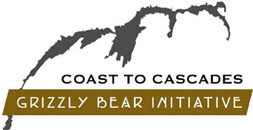In April 2015, the Forest Practices Board (FPB), BC's independent watchdog for sound forest practices, released a special report on Access Management and Resource Roads. The report lays bare the extent and severity of the issues with resource roads, which create fracture lines through habitat and reduce the ability of wildlife (not just grizzly bears) to move around and remain safe.
The following is taken from the Executive Summary of the FPB Access Management and Resource Roads 2015 Update Report, which revisited concerns previously raised in 2005:
"Natural resource industries require access to the places they work. This almost always means a road. Those roads also provide access to the ‘back country’ for the public, First Nations and many other commercial interests (e.g., ranching and adventure tourism). However, the roads themselves, and the human access they provide, arguably cause the most significant negative environmental effects of natural resource development, such as landslides, siltation of streams, alteration of natural drainage patterns and the loss and degradation of wildlife habitat. The Board believes that it is time to take action to improve management of the multi-billion dollar asset represented by BC’s resource roads.
After more than a century of forestry, oil and gas and mining activities, there are over 600,000 kilometres of resource road in BC (enough to drive from Vancouver to Halifax and back 50 times). This enormous legacy is growing—on the order of 10,000 kilometres is being added every year. Over 75 percent of resource roads were built by the forest industry. Most of the remainder were built by the oil and gas industry in northeastern BC. A small, but significant, amount was built by other industries, notably the mining industry. Over half the resource roads are not being maintained. Much of that unmaintained road has been deactivated, but there is still potential for some of those roads to cause environmental damage and some continue to provide unintended access."
The report highlights actions which would help reduce or eliminate the challenges resulting from resource roads, many of which COASTtoCASCADES point to as actions that would reduce the vulnerability of the threatened grizzly bear units in BC. These solutions include:
- Decommissioning roads once they are no longer needed by industry, thereby preventing unintentional access;
- Placing seasonal closures on some roads, for example implementing spring closures in areas where females and cubs are known to be active to provide safety when they emerge from the den and are extremely vulnerable;
- Undertaking Access Management Plans, which balance the needs of multiple stakeholders, and includes representation for wildlife, to set carrying capacities for roads which are sustainable for a specific area;
- Developing Land Use Management Plans, setting out the values and preferred uses of areas of land, gauging the cumulative effects of multiple uses on the land and develop consensus over the highest and best use of land.
Implementation on the ground is often the greatest challenge. Seasonal or complete closures of roads cost (industry) money and prevent public access, which is the conversation from a land management focus to political contexts. Development of Land Use and Access Management Plans is often a major undertaking when all stakeholders are engaged. Recommendations in these plans need to be realistic in terms of capacity to deliver, budgets and support for implementation on the ground. The 2008 Sea-to-Sky Land and Resource Management Plan (LRMP) overlaps 4 of the 5 threatened grizzly bear populations of southwest BC and includes recommendations for the recovery of grizzly bears (pg. 73). At COASTtoCASCADES we refer to the LRMP recommendations as guiding principles for development of on the ground action, because they were developed through extensive stakeholder collaboration and have been endorsed by local and provincial governments. Lets hope that on the 10 year anniversary of the LRMP we are able to paint a brighter picture of progress than the FPB paints for our collective ability to manage the challenges presented by resource roads.
Resource roads are not just a BC problem. In Alberta the Foothills Research Institute has been monitoring the impacts of resource roads on grizzlies for many years. Listen to Gord Stenhouse in a March 2014 interview with the CBC as he talks about why bears are attracted to roads and why that its them in danger and gives rise to population declines, the same principle apply for the bears of BC. (Interview starts at 14:50 minutes).

